A keloid scar is the result of an excessive increase in connective tissue that occurs at the site of the fusion of the skin in the postoperative period.
Most doctors agree that such scars are caused by a violation of the mechanism of the structure of the connective tissue in the human body and the excessive production of collagen.
Violation of the integrity of the skin is fraught with several types of scars:
- hypertrophic scar - differs from the skin in color and rises above the wound;
- atrophic scar - forms "cavities", is located below the skin level;
- a keloid scar is a scar that extends beyond the boundaries of the wound;
- normotrophic scar - located on the surface of the skin.
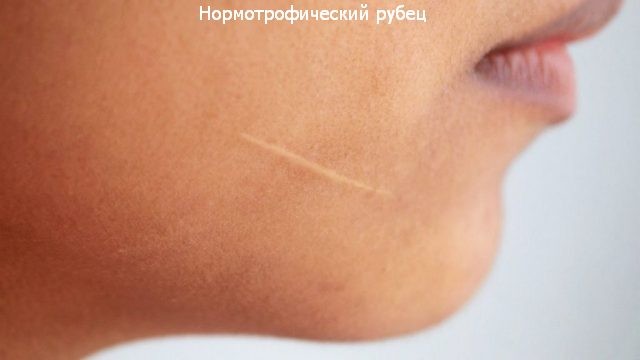
A keloid scar is a smooth formation with a dense structure and evenly defined edges. The growth has a red, bluish or purple tint, which is explained by the ingrowth of small capillaries into the skin. The boundaries of the keloid are located far beyond the edges of the wound itself and differ sharply from the tissues around.
Keloid scars can interfere with movement. This is an especially common problem when there is a formation in the area of the joint or facial muscles of the face.
The formation of a keloid scar is accompanied by pain. It can be tingling, burning, itching, and recurrent pain. The danger of such an outgrowth is a high probability of relapse after treatment and a high capacity for permanent growth.
What causes and how keloid scars appear on the body, on the head, on the face, in the ears
Keloid formation begins after the first restoration of the skin due to injury. At the site of a healed wound or cut, small seals begin to appear, accompanied by discomfort. Lumps enlarge, going beyond the scar, and acquire clear contours.
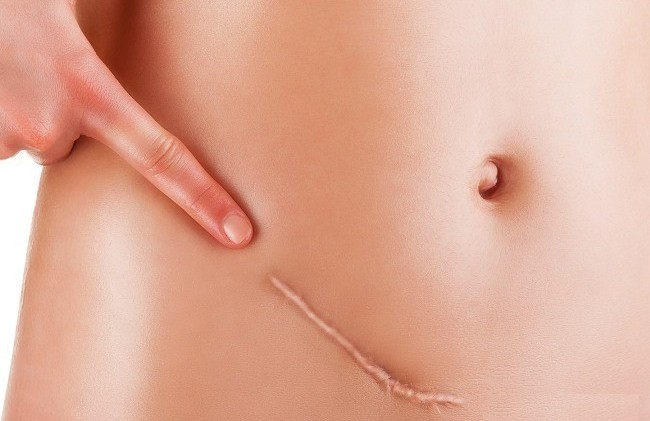
- hereditary predisposition;
- wound infection;
- unstable hormonal background;
- incorrect matching of the cut edges;
- strong skin tension in the area of the cut;
- pregnancy;
- insufficient wound care;
- immune problems.
The neoplasm occurs under the influence of an imbalance in the production of collagen and elastin.
Normally, they are provided by fibroblast cells and lead to wound healing.When the border of the injured skin is violated, collagen fibers grow and provide a scar.
Open skin areas are considered the most vulnerable to keloid scar formation. These are the area of the ears, neck, chest, upper back, face and shoulders.
Scars after mole removal
A keloid can form at the site of removal of a mole as a result of irregularities in the body and improper care of the injured area.
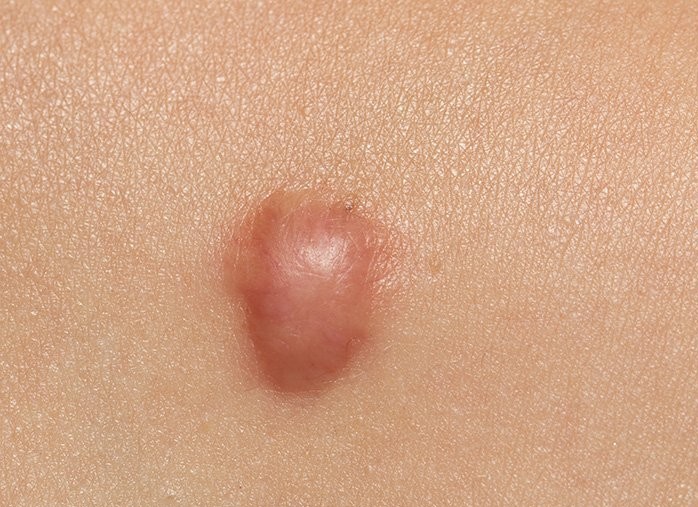
Scars after rhinoplasty
Keloids after rhinoplasty are often the result of poor skin care. The area of the nose is prone to inflammation. Having experienced stress from the operation, the skin often changes its type, the sebaceous glands begin to work more actively.
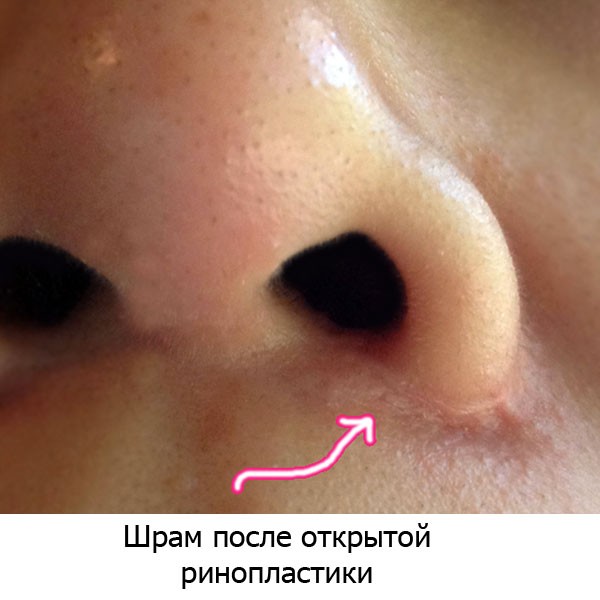
Scars after blepharoplasty
Blepharoplasty is used to get rid of fine wrinkles, bags under the eyes and other cosmetic imperfections in the upper and lower eyelids. In this case, a keloid scar is one of the rare negative outcomes, since the procedure is performed with small incisions in the skin.
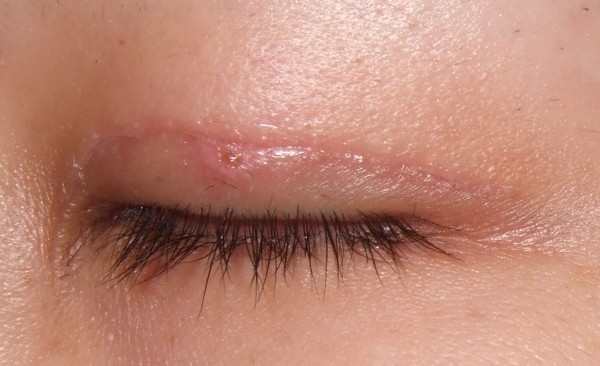
Scars after mammoplasty
Keloid scar is one of the possible skin healing disorders after mammoplasty. Small stitches remain in any case, but they become invisible during the normal course of healing.
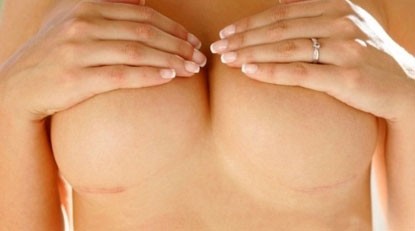
Scars after biorevitalization
Biorevitalization is considered one of the treatments for some types of scars.
Efficiency is achieved by carrying out biorevitalization together with laser procedures. The injections accompany tissue healing after laser resurfacing.
As a rejuvenating procedure, biorevitalization is contraindicated for people prone to the formation of keloids, since even a small violation of the integrity of tissues, but in large quantities, can cause scarring.

 Don't miss the most popular column article: Plasmolifting of the face - what it is, how it is performed, results, photos before and after the procedure.
Don't miss the most popular column article: Plasmolifting of the face - what it is, how it is performed, results, photos before and after the procedure.Scars after piercing
The likelihood that the result of skin healing will result in a keloid scar is quite high among piercing enthusiasts. This is due to a genetic predisposition and improper care of the puncture site.
The overgrowth of the keloid also provokes piercing jewelry, which creates additional tension. In addition, the earring creates friction against the skin, which also negatively affects healing.
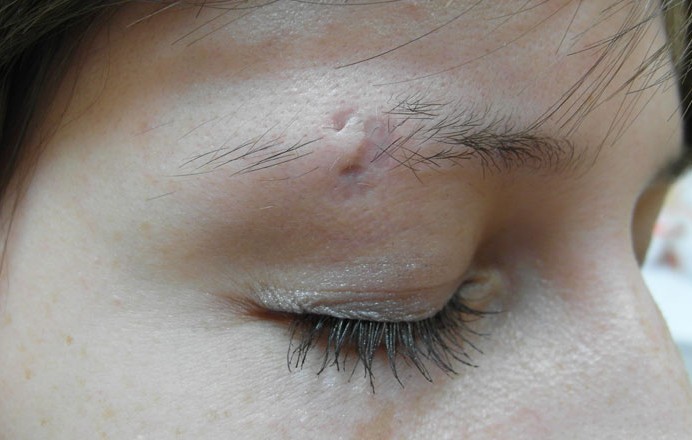
Scars after acne, pimples
Even a common pimple can cause a keloid scar, if there is a predisposition to this. People with dark skin are more likely to face this problem. Acne marks increase in size and become keloids one month after the initial healing.
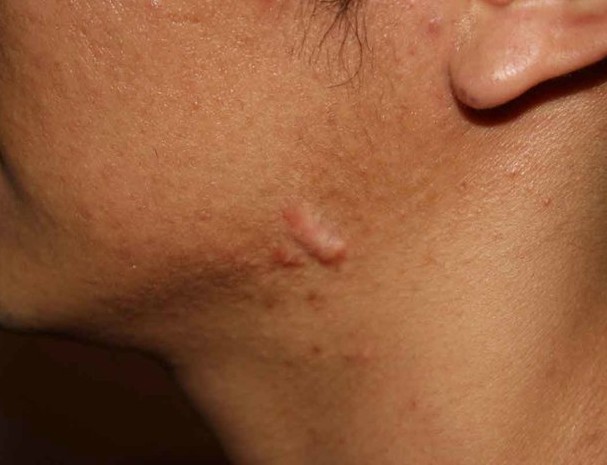
Post-burn scars
As a result of the burn, a keloid scar may form.This is possible if there is a predisposition and the degree of skin damage is severe. A chemical or thermal burn leads to the formation of a keloid on any part of the body.
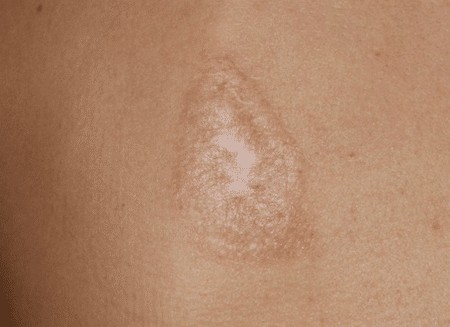
How to remove keloid and hypertrophic scars after surgery. Removal by laser. Reviews
The following methods are used to treat keloid scars:
- Injections... Exposure to hormonal drugs limits cell activity and inhibits the growth of connective tissue. The injection is made directly into the scar. After the administration of the drug, the keloid loses its color. For a positive result to appear, a course of injections is required, which includes 5-6 injections. The likelihood of a positive outcome of therapy increases when using injections with other methods of treatment;
- Compression bandage... Shrinking the tissue inhibits scar growth, promotes thinning, and limits its mobility. This method is used in combination with others;
- Laser treatment... The keloid scar changes markedly when exposed to a laser. This is one of the most effective treatments.
To achieve a positive effect, the scar must pass into the stage of maturity, stop growing. For this, hormonal preparations and ointments are applied to the affected area, as a result of which the scar loses its color and becomes soft. Only ablative resurfacing is allowed, acting directly on the scar tissue.
Laser resurfacing "vaporizes" the scar, making it less visible.
Patients notice a decrease in the volume of the keloid, loss of color and a change in structure after the first procedure. Tingling and burning sensation is felt during treatment, which is normal. If a large area is being treated, anesthesia should be used.
After laser treatment, the scar will require special care. The doctor will indicate the frequency of treatment with a disinfectant and a healing cream. Chlorhexidine and Bepanten are commonly used.
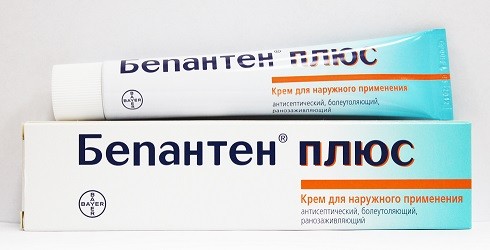
Removal of keloid scars with liquid nitrogen - cryotherapy. Reviews
This method of treatment is classified as a conservative type of scar correction. The procedure requires a liquid nitrogen spray, a cotton swab, and an analgesic (if the scar is large).
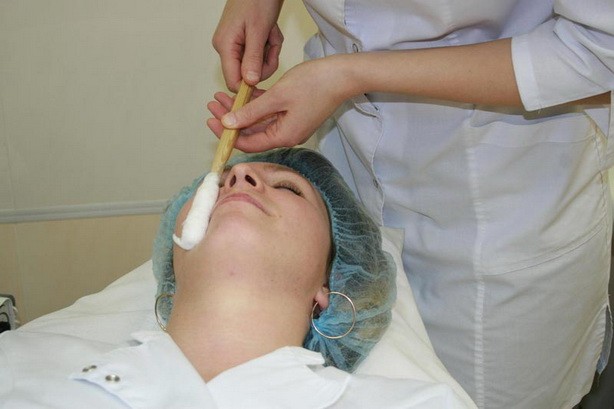
The advantage of removing the scar with nitrogen is that it reduces the risk of wound infection. The low temperature kills the microflora of the skin, preventing infection. If infection does occur, this can be judged by swelling and redness on the scar.
After exposure to nitrogen, a formation appears in the form of a bubble with a liquid, which should not be pierced on its own. Patients notice an improvement in the appearance of the skin, a change in the size and brightness of the keloid. In this case, the scar does not completely disappear.
To achieve the result, it is necessary to act with liquid nitrogen on the keloid scar for 2-10 minutes, with breaks for thawing.
Treatment of keloid scars - drugs, ointments, creams. Before and after photos
Drug treatment is used both as an auxiliary or preparatory therapy before another type of exposure, and as the main method of treatment.
Ointments and creams basically contain collagen of various origins, which creates a film on the skin surface. The film prevents moisture loss by moisturizing the keloid surface. At the same time, hydration promotes healing and normalization of tissue processes.
"Diprospan"
The medicinal product is available in 2 forms:
- suspension;
- injection.
It is a hormonal agent.

"Kontraktubex"
The action of the gel is provided by the following components:
- allantoin - relieves itching and burning during healing, normalizes pigmentation, softens scars, and also activates blood circulation in the affected tissue;
- sodium heparin - makes the structure of the scar less dense, saturates the tissue with moisture and has an anti-inflammatory effect;
- zepalin (onion extract) - inhibits the development of fibroblasts, preventing scar formation and growth.
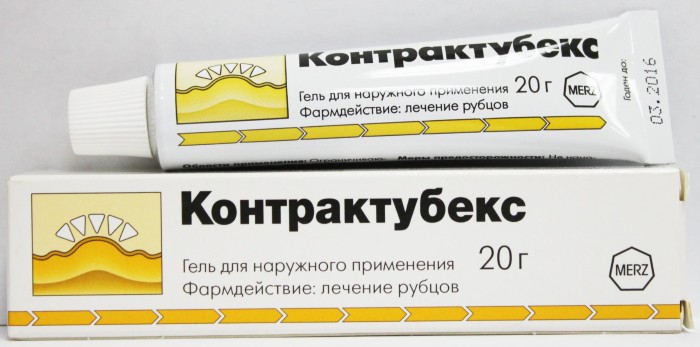
The drug received more positive reviews in the treatment of acne marks. The patients were unable to significantly reduce the keloid with this gel.
"Lidaza"
The basis of the drug "Lidaza" is hyaluronic acid, which fills the cells and stimulates the processes of decay in the scar tissues. In this case, there is no effect on the collagen-collagenase system.
Available in solution for internal use and powder for external use.
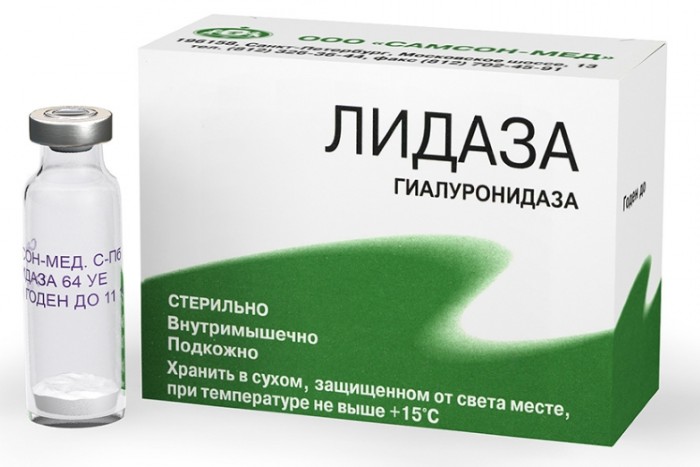
"Solcoseryl"
Solcoseryl contains deproteinized dialysate from the blood of calves, which stimulates cell regeneration by supplying glucose and oxygen. The most popular forms of release are ointment and jelly. The concentration of the active substance in the jelly is higher.
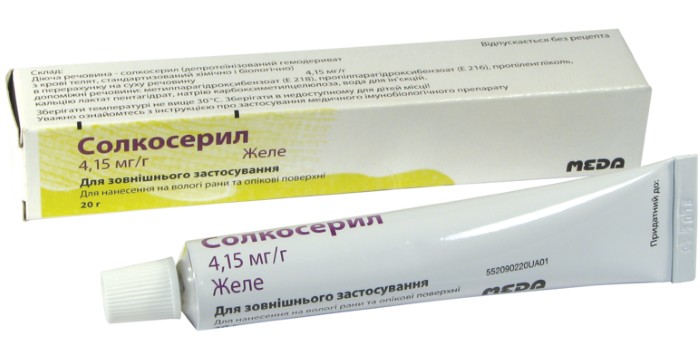
Kenalog
The keloid scar is almost completely removed with Kenalog. It is a drug that causes tissue atrophy. It is used in the form of a course of injections with a frequency of 1 month to six months. The complete course of treatment depends on the age of the scar, its area and size.
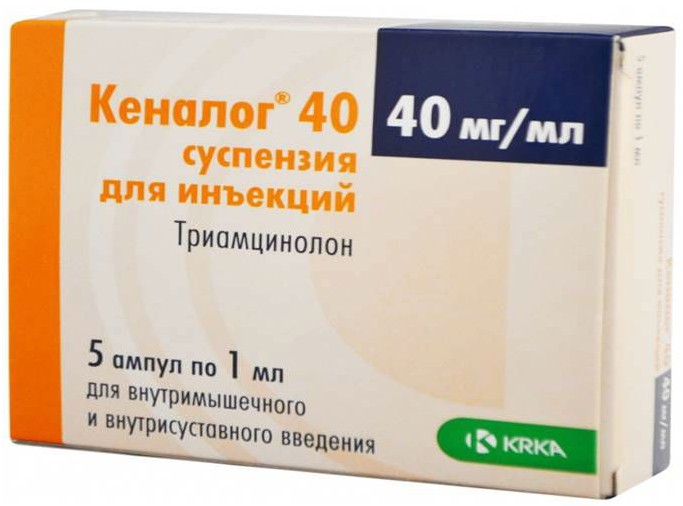
The patients who used this remedy noted a long-term positive effect.
"Dermatiks"
Among the many remedies for scars, this drug will stand out for its effectiveness. Available in the form of a gel and a dressing on a gel basis (fabric and silicone). It has a superficial effect due to the silicone in the composition, makes the keloid scar flat.
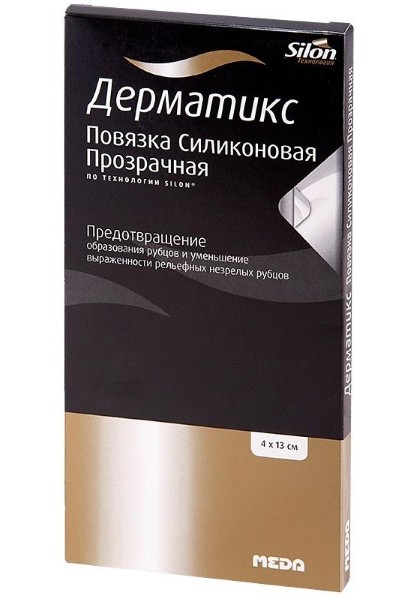
The effectiveness of using ointments and creams increases when they are applied under a squeezing bandage for several hours.
How to cure keloid scars at home - treatment with folk remedies
Traditional medicine for the removal of keloid scars recommends the following methods:
- compresses from extracts of chamomile, fennel, St. John's wort;
- massage with sea buckthorn oil;
- rubbing in fresh honey;
- lubricating the surface of the keloid with rosemary and tea tree oil. These oils are essential, so they should be used in combination with a base oil;
- compress from chopped cabbage leaves and honey.
The effectiveness of these methods has not been proven. They can be used as an adjunct to mainstream therapy in consultation with your doctor.
How to hide a keloid scar - tattoo, permanent make-up
A keloid scar can be hidden with a tattoo or tattoo. These methods involve stuffing a long-term pattern directly on the problematic area of the skin, thereby masking the aesthetic defect.
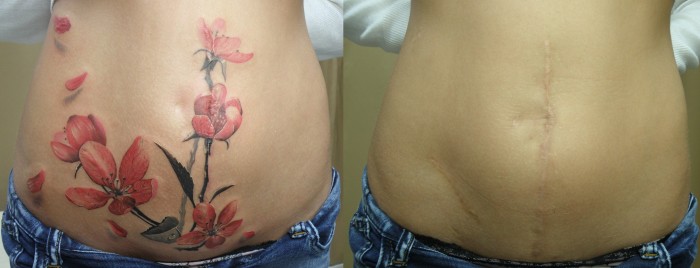
What is a keloid scar and how to get rid of it: video
What causes keloid scars and how to deal with them - specialist recommendations:
Is it a keloid or hypertrophied scar? Doctor's explanations:
A keloid scar is an unpleasant cosmetic problem, the solution to which lies in complex competent treatment. The best result is achieved by a combination of active methods of treatment (laser, cryotherapy, physiotherapy) and local effects of drugs (ointments, creams and injections).


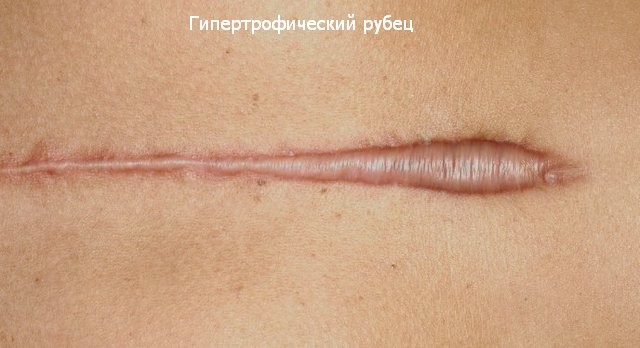
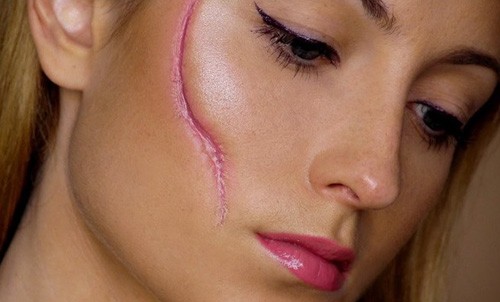
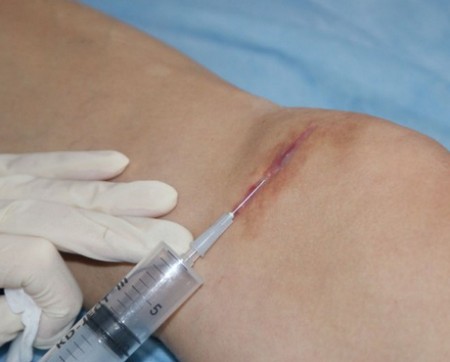
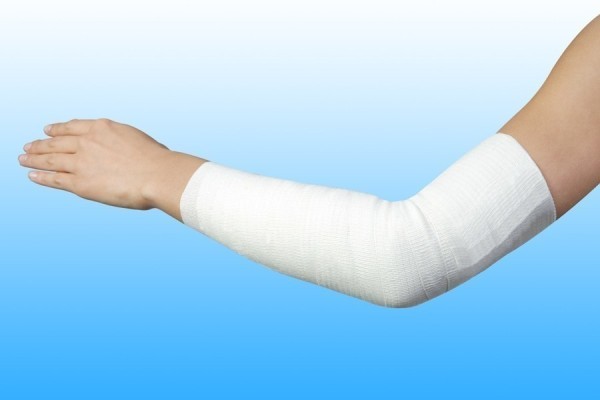
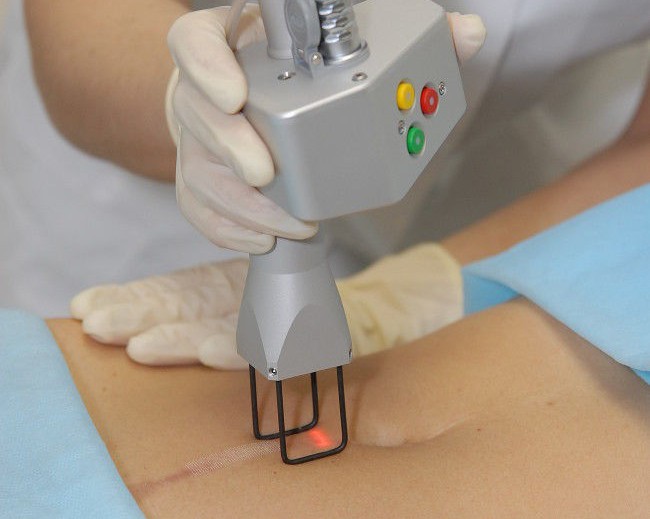
Once I fell unsuccessfully on the stairs, there was a scar at hand. I never thought that you can get rid of him. You can try some "home" methods.